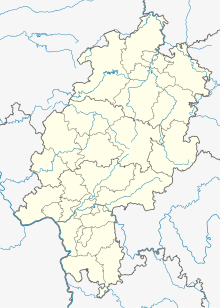Klein-Kerstenhausen
Coordinates: 51 ° 3 ′ 48 ″ N , 9 ° 13 ′ 45 ″ E
Klein-Kerstenhausen (also Kleinkerstenhausen ) is a deserted village in the district of Kerstenhausen , a district of Borken in the Schwalm-Eder district in northern Hesse .
geography
The settlement was about 1 km southeast of Kerstenhausen on the county road 73 from Kerstenhausen to Arnsbach at about 195 m above sea level at the foot of the Kuhberg ( 342.9 m ) on the right, southern bank of the Schwalm , which here from the Löwensteiner Grund through the Schwalmpforte breaks through into the Schwalmaue . The Kerstenhausen sports field is located around 150 m to the northeast.
About 50 m south of the county road 73 is on the northwest edge of a field 206 m above sea level. NHN an approximately 40 × 20 m large, almost rectangular field wood island on a low rubble hill . These are the remains of the former village church, the Margarethenkirche . In addition to the remains of a wall from a former mill on the Schwalm, the ruins of the church are the only remaining visible remnants of the village, which was last mentioned in 1578 as a single courtyard. Locally nor are place names "Margarethe Acker" and "Church Stump" common.
traffic
The district road 73 from Kerstenhausen to Arnsbach runs between the remains of the Margaret Church in the north and the former village in the south. It branches off not far southeast of Kerstenhausen on the north bank of the Schwalm from the federal highway 3 , which crosses the Schwalmpforte here and at its eastern exit at the Borken junction under the federal highway 49 .
history
The place was first mentioned in 1314 as "villa minoris Kerstinhusen" as a landgrave Hessian village in the Borken office when Werner von Löwenstein-Westerburg sold two Hufen arable land to the plebane and rector of the church in Urff . Since the investiture of Henry Lowenstein by Landgrave Ludwig with village and court small Kerstenhausen than men and Burglehen is emphasized in 1447 that even Henry ancestors occupied this fief, in particular, according to one of the Duchess Sophie von Brabant issued Lehnsurkunde, However, the place existed much earlier.
The place, located in the extreme northeast of the Löwensteiner Grund, named after the dominant sex in the area, was at least partially owned by this family for a long time, but over the centuries ecclesiastical institutions and other noble families also acquired property or income in the village. In 1339 Landgrave Heinrich II gave the place Kleynenn Kirstenhusenn with court, validity and gradient as a hereditary castle loan to the von Löwenstein . From 1340 z. B. the St. Petri-Stift in Fritzlar and the rector of the Marien Altar there declared as the owner of income from Klein-Kerstenhausen, which they received from those of Löwenstein, and in 1362 the Eppenberg women's choir appears and in 1445 the Carthusian monastery of St. Johannis as a lender from several hubs in town. The Löwensteiner Burglehen zu Klein-Kerstenhausen was finally redeemed in 1480 by Landgrave Wilhelm I for 120 marks of silver, which was confirmed again by the Löwensteiners in 1491 and 1501. Landgrave Wilhelm II pledged the village again briefly in 1493 to Philipp von Wildungen and in 1500 to a Löwenstein zu Löwenstein.
The village church consecrated to Margaret of Antioch is first mentioned in a document in 1344 and appears again in 1464 as "ecclesia in minore Kerstenhusen". The church patronage was owned by von Löwenstein and the community probably had its own pastor until the 16th century.
The small village was apparently largely abandoned around the middle of the 16th century: in 1578 there is only talk of a single farm, and the church was now looked after by an outside pastor. The residents moved to Kerstenhausen, already mentioned as "Christinehysen" in 1044, upstream on the left bank of the Schwalm, which was probably less prone to flooding and not as windy as the location directly in the narrow Schwalmpforte. The Margarethenkirche, now no longer so easy to reach on the other bank of the river, gradually fell into disrepair.
Footnotes
- ↑ In historical documents the following forms of name can be found: 1314 minor Kerstinhusen, 1339 Kleynenn Kirstenhusenn, 1340 minor Kerstenhussen, 1340 inferior Cresteynhusen, 1447 Kleynen Kerstenhusen, 1471 Cleyne Kerstenhußen, 1493 Kleinen Kirstenhusen, 1501 Kleinen Krestenhusen, 1515 Krestenhusen, 1515 Kleinen 1536 Kleynen Kerstenhausen, 1550 Clein Kerstenhausen, 1551 Wenigen Kerstenhausen and 1568 Kleinenn Krestennhaußenn.
- ↑ Apparently during her reign in Hesse between 1247 and 1263.
- ↑ Werner Ide: From Adorf to Zwesten. Local history pocket book for the Fritzlar-Homberg district. A. Bernecker Verlag, Melsungen, 1972, p. 219
- ^ Georg Landau : Historical-topographical description of the desolate localities in the Electorate of Hesse .... , (Journal of the Association for Hessian History and Regional Studies; Seventh Supplement). Fischer, Kassel, 1858, p. 145
- ↑ Werner Ide: From Adorf to Zwesten. Local history pocket book for the Fritzlar-Homberg district. A. Bernecker Verlag, Melsungen, 1972, p. 219
- ^ Georg Landau: Description of the Hessengau. Barthel, Halle, 1866, p. 177
Web links
- "Kleinkerstenhausen (desert), Schwalm-Eder district" ,. Historical local dictionary for Hessen. In: Landesgeschichtliches Informationssystem Hessen (LAGIS).
- "Margarethenkirche, Schwalm-Eder-Kreis". Historical local dictionary for Hessen. In: Landesgeschichtliches Informationssystem Hessen (LAGIS).
literature
- Werner Ide: From Adorf to Zwesten. Local history pocket book for the Fritzlar-Homberg district. A. Bernecker Verlag, Melsungen, 1972, pp. 218-219 and 255-256.


